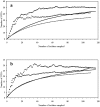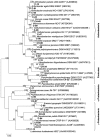Culturable bacterial diversity from the chestnut (Castanea sativa Mill.) phyllosphere and antagonism against the fungi causing the chestnut blight and ink diseases
- PMID: 31294162
- PMCID: PMC6605015
- DOI: 10.3934/microbiol.2017.2.293
Culturable bacterial diversity from the chestnut (Castanea sativa Mill.) phyllosphere and antagonism against the fungi causing the chestnut blight and ink diseases
Abstract
The phyllosphere supports a large and complex bacterial community that varies both across plant species and geographical locations. Phyllosphere bacteria can have important effects on plant health. The sweet chestnut (Castanea sativa Mill.) is an economically important tree species affected worldwide by the fungal pathogens Cryphonectria parasitica and Phytophthora cinnamomi. We examined the culturable phyllosphere bacterial community of the sweet chestnut at two nearby locations in Central Spain in order to know its geographical variability and to explore its potential as source of biological control agents against these two pathogenic fungi. The bacterial diversity at strain level was high but it varied significantly between locations; however, phylotype richness and diversity were more comparable. The isolates were affiliated with the phyla Actinobacteria, Firmicutes and Proteobacteria. Most of them were members of recognized bacterial species, with a notable proportion of representative of the genera Dietzia and Lonsdalea, but a small fraction of the strains revealed the existence of several potential novel species or even genera. Antagonism tests showed the occurrence in the chestnut phyllosphere of bacterial strains potentially useful as biological control agents against the two pathogenic fungi, some of which belong to species never before described as fungal antagonists. Chestnut phyllosphere, therefore, contains a great diversity of culturable bacteria and may represent an untapped source of potential biocontrol agents against the fungi causing blight and ink diseases of this tree species.
Keywords: Castanea sativa; Cryphonectria parasitica; Phytophthora cinnamomi; bacterial diversity; bacterial-fungal antagonism; phyllosphere.
Conflict of interest statement
Conflict of Interest: All authors declare no conflicts of interest in this paper.
Figures





Similar articles
-
First Report of Chestnut Blight Caused by Cryphonectria parasitica in a Chestnut Orchard in Andalusia (Southern Spain).Plant Dis. 2014 Feb;98(2):283. doi: 10.1094/PDIS-07-13-0781-PDN. Plant Dis. 2014. PMID: 30708770
-
Resistance to Phytophthora cinnamomi in American Chestnut (Castanea dentata) Backcross Populations that Descended from Two Chinese Chestnut (Castanea mollissima) Sources of Resistance.Plant Dis. 2019 Jul;103(7):1631-1641. doi: 10.1094/PDIS-11-18-1976-RE. Epub 2019 Apr 29. Plant Dis. 2019. PMID: 31033400
-
Regional Variability of Chestnut (Castanea sativa) Tolerance Toward Blight Disease.Plants (Basel). 2024 Oct 31;13(21):3060. doi: 10.3390/plants13213060. Plants (Basel). 2024. PMID: 39519976 Free PMC article.
-
The Disease Triangle of Chestnut: A Review of Host, Pathogen, and Environmental Interactions of Chestnuts Cultivated in the Eastern United States.Plant Dis. 2025 Feb;109(2):245-256. doi: 10.1094/PDIS-11-23-2355-FE. Epub 2025 Jan 31. Plant Dis. 2025. PMID: 38853336 Review.
-
European and American chestnuts: An overview of the main threats and control efforts.Front Plant Sci. 2022 Aug 24;13:951844. doi: 10.3389/fpls.2022.951844. eCollection 2022. Front Plant Sci. 2022. PMID: 36092400 Free PMC article. Review.
Cited by
-
Diversity of culturable methylotrophic bacteria in different genotypes of groundnut and their potential for plant growth promotion.3 Biotech. 2018 Jun;8(6):275. doi: 10.1007/s13205-018-1291-2. Epub 2018 May 26. 3 Biotech. 2018. PMID: 29868313 Free PMC article.
-
Epiphytic and endophytic bacteria on Camellia oleifera phyllosphere: exploring region and cultivar effect.BMC Ecol Evol. 2024 May 13;24(1):62. doi: 10.1186/s12862-024-02240-3. BMC Ecol Evol. 2024. PMID: 38735962 Free PMC article.
-
Four novel Curtobacterium phages isolated from environmental samples.Arch Virol. 2023 Feb 14;168(3):89. doi: 10.1007/s00705-023-05706-9. Arch Virol. 2023. PMID: 36786922
References
-
- Conedera M, Krebs P, Tinner W, et al. The cultivation of Castanea sativa (Mill.) in Europe, from its origin to its diffusion on a continental scale. Veg Hist Archaeobot. 2004;13:161–179.
-
- Fernández-López J, Alía R. Technical guidelines for genetic conservation and use for chestnut (Castanea sativa) Rome, Italy: EUFORGEN; 2003.
-
- Braga N, Rodrigues F, Beatriz M, et al. Castanea sativa by-products: A review on added value and sustainable application. Nat Prod Res. 2015;29:1–18. - PubMed
-
- Bounousa G. Perspectives and future of the chestnut industry in Europe and all over the world. Acta Hortic. 2014;1043:19–22.
-
- Gomes-Laranjo J, Araujo-Alves J, Ferreira-Cardoso J, et al. Effect of chestnut ink disease on photosynthetic performance. J Phytopathol. 2004;152:138–144.
LinkOut - more resources
Full Text Sources
